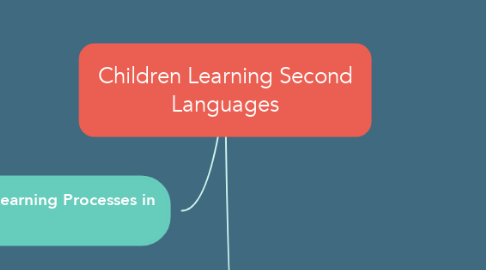
1. Language Learning Processes in Childhood
1.1. First language acquisition in childhood
1.1.1. Preschool years
1.1.1.1. Young children’s communication is very much related to their everyday experiences and they are not yet able to communicate in a de-contextualised manner.
1.1.2. Primary school years
1.1.2.1. Children become more explicit, more precise, and more listener-friendly when constructing messages
1.1.3. Post-primary school years
1.1.3.1. Many further, subtle structural refinements take place in addition to the massive acquisition of more marked lexis.
1.1.4. Some language learning theories/approaches
1.1.4.1. Behaviourism
1.1.4.2. Universal Grammar/nativist approach
1.1.4.3. Cognitive approaches
1.1.4.4. Input and interactions
1.1.4.5. Socio-cultural perspectives
1.2. Second language acquisition in childhood
1.2.1. Critical Period Hypothesis
1.2.1.1. "There is a limited developmental period during which it is possible to acquire a language, be it L1 or L2, to normal, native-like levels."
1.2.1.1.1. In L1: agreement about the existence of a weak form of a CPH for first language acquisition.
1.2.1.1.2. In L2: it is associated with a ‘heightened plasticity’ in the brain which is lost, at least partially, once the brain becomes lateralised and stiff.
1.2.2. Rate of development: older learners’ advantage?
1.2.2.1. In natural contexts older learners have an initial advantage over younger learners but younger learners tend to catch up in the long run.
1.2.3. Ultimate attainment: younger learners’ advantage?
1.2.3.1. Older learners progress faster initially, but younger learners often overtake them in the long run. This implies that younger learners are likely to have an advantage when it comes to ultimate attainment.
1.2.4. Factors such as supportive contexts, opportunities to practise, motivation and the quality of formal instruction all make a difference, and age simply cannot be separated and examined in isolation.
1.2.4.1. There is no clear evidence for the existence of the critical period for L2 acquisition, but instead, social, environmental and individual factors help to explain many young children’s success.
2. Theories of Child Development
2.1. Piaget's theory of child development
2.1.1. Piaget’s stages of development
2.1.1.1. Implications
2.1.1.1.1. Formal operational children were much more adept at generating more abstract and hypothetical solutions than were the younger children.
2.1.1.2. Piaget argues that all children follow the same stages of development in the exact same order.
2.1.2. Criticism of Piaget
2.1.2.1. Piaget focuses on deficiencies rather than achievements.
2.1.3. Schemes
2.1.3.1. This is the process of organization. At the same time, children need to compare and adjust their developing schemes to match what they encounter in their environment. This process of adjusting is referred to as adaptation. Adaptation actually consists of two sub-processes: assimilation (interpreting new knowledge in terms of old models/ schemes they already possess) and accommodation (modifying these existing structures to fit the new knowledge).
2.2. Vygotsky’s theory of development
2.2.1. The zone of proximal development (ZPD)
2.2.1.1. Implications
2.2.1.1.1. It is important to pay attention to individual differences and consider alternative ways and levels of assisting learners.
2.2.1.1.2. In the process of working together learners are using language (L1 or L2) as a psychological tool and they offer assistance to one another within their respective ZPD.
2.2.1.2. It is the distance between the actual developmental level and the level of potential development under adult guidance or in collaboration with more capable peers.
2.2.1.3. Scaffolding
2.2.1.3.1. It is a special type of assistance that experts provide to novices while jointly engaged in a problemsolving task.
2.2.2. the construction of knowledge and understanding is an inherently social activity.
2.2.3. Criticism of Vygotsky
2.3. The information processing (IP) approach
2.3.1. Following the computer analogy, the human mind is studied both in terms of its hardware, and its software.
2.3.1.1. Storage: The mind as a multistore model
2.3.1.1.1. short-term memory store.
2.3.1.1.2. long-term store
2.3.1.1.3. The basic memory span of a 2-year-old is just two items, the span of a 5-year-old is four items, the span of a 7-year-old is five items and the span of a 9-year-old is six items,
2.3.1.1.4. Young children are biased towards storing and retrieving verbatim traces.
2.3.1.2. Attention
2.3.1.2.1. It improves with age, which means that children get better at keeping their attention on the core features of the task
2.3.1.3. Expertise
2.3.1.3.1. It can enhance our ability to store, remember and retrieve information.
2.3.1.4. Mental representations
2.3.1.4.1. Children progress from a more perceptually organised representation base to a more conceptually organised representation base.
2.4. Emotional development
2.4.1. children’s language learning is embedded in their emotional development.
2.4.1.1. It is important to consider friendship groups for group and pair work as well as classroom research, as children tend to respond better to tasks in a secure, friendly environment.
2.4.1.2. Building positive self-esteem and a positive L2 self-image Encouraging pair and group work among friends
